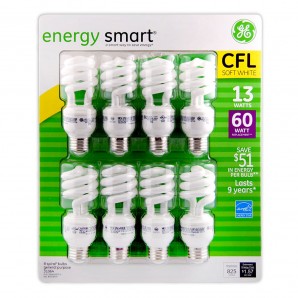|
With so many advances in the world of LEDs, we thought we'd take time to update some of the old data online comparing this digital technology with the non-digital technologies of CFL and incandescent bulbs. This seems especially useful now that your average household incandescent has been phased out of production and importation, and many people have found that CFL bulbs don't last as long as they were first promoted to.
A Review of CFL Bulbs
Let's first touch on that point of CFLs: many packages originally said they would last (or have an average rated life of) 10,000 hours. However, this is under conditions that take advantage of how they work, which means using them in areas where they're typically left on at least 15 minutes at a time. In frequent "on/off" locations like bathrooms or closets, their lifespan could drop dramatically. CFLs also don't come on to full brightness right away, most don't dim, and most don't work well in the cold.
Having said this, they were an important option when people were starting to look for energy savings from their light bulbs, as they use only about 25% of the energy consumed by incandescent bulbs. Usually for $5 or less (some years ago), you could replace your 50 cent incandescent bulb with something that would last 10 times as long (in fact more like 5 to 10 times as long), so the cost of the bulbs themselves evened out. Meanwhile, you would slash your energy bill. Given that lighting makes up about 10% to 15% of a residential electric bill when you're using incandescent bulbs, this could cut electric bills by roughly 8% to 11%. And while LEDs in the early days were slightly more efficient than CFLs, they also cost around $20 to $40 per bulb and most people couldn't afford them. But that's no longer the case, so now let's get an update on the world of LEDs. A Review of Today's LED Bulbs
Today, CFL bulbs have continued to plummet in prices and you can sometimes pick them up for around $1 each. But meanwhile, LED bulbs have become affordable as well with prices ranging from $3 to $10 (depending on the quality and features) for household (A19) replacement bulbs. Or if you spent more, you could get "smart" LED bulbs, but that's a topic for another day.
Meanwhile, the efficacy of LEDs has continued to improve. This means they're producing more light, or lumens, for every watt of energy used. For instance, you can replace a 60-watt incandescent bulb with a 13 or 14-watt CFL -- an efficacy of up to about 60. Early LEDs had a similar efficacy, and may have only saved you 1 watt in a 60-watt replacement. But today's LEDs, while far lower in cost, have boosted their efficacy and now approach 100. This means you can save up to 4 or 5 watts per bulb. If this doesn't seem like much, keep in mind that the average light bulb is used for around 1.6 hours per day, or 500+ hours per year, and this difference could yield $3 to $4 in energy savings each year. So an LED could pay for itself against a CFL within 1-2 years and then start keeping money in your pocket every year after that. Not bad for a technology that may last you 20 years! Plus, LED efficacy is expected to continue rising, and to reach around 150 by 2020. Even better, the quality of LEDs continues improving as well. Today, some LED bulbs approach a 100 CRI, which means they score almost perfectly on the Color Rendering Index. (This is a complex topic, however, as different technologies render colors differently, even if scoring a similar number on this scale.) Meanwhile, some LED technology now make the bulbs even more closely mimic incandescent bulbs, which provide a warm color that many people love. This new technology means that the bulbs not only mimic the color temperature of incandescent bulbs at full brightness, but they also get warmer -- like incandescent bulbs do -- when dimmed.
|
This blog's content is copyright © 2014-19 Lighting Supply.
